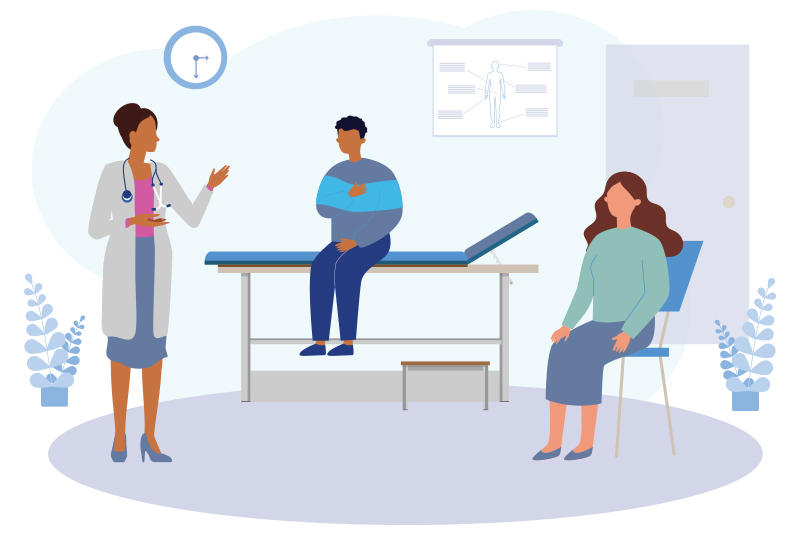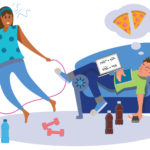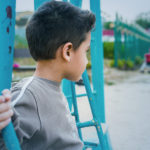Keeping kids emotionally healthy during COVID-19

Children and teens have suffered immensely during the COVID-19 pandemic. Changing school and family routines, isolation at home, illness or loss of a family member, stressed parents, and fear of the virus itself have hit kids hard. And sadly, the pandemic continues with the rise of new COVID-19 variants.
Pediatric practices can play a role in supporting children and parents during this time, and can potentially have a big impact on patients’ current and future well-being.
“At well-child visits and sick-child visits, ask about how COVID is affecting the family,” advises Elizabeth Rider, MSW, MD, a Boston Children’s pediatrician and former child and family therapist. “It’s important to look at the whole child and the whole family and think about what the child needs.”
In a comprehensive Practice Pointer article in BMJ, Rider and her colleagues suggest that pediatric clinicians compare their findings with the child’s well-being and mental health status before the pandemic. Look for responses that could indicate a mental health disorder that requires referral.
Screening for emotional distress
Most patients’ reactions to the pandemic will be in keeping with developmental expectations. But some children and teens may be at risk for more serious distress, even when they don’t show obvious signs. Those who have experienced a prior trauma or have a prior behavioral health problem, learning disability, or physical disability tend to face greater challenges to their mental health and wellbeing.
In screening patients, ask parents about family challenges, such as financial hardship or inadequate internet or device access for learning. “Maybe the family is locked down with an abuser, maybe they don’t have food, maybe a grandparent has died,” says Rider. “These can be difficult conversations, but they are essential to understand the child’s and family’s situation, and parents are grateful for the effort.”
Children of different ages may react differently, so be aware of developmental stages. For young children (age 3 to 5), Rider suggests questions like:
- Did you hear about the virus that has been making some people sick?
- Did you know about anyone who got sick? What happened to them?
- Do you think anyone else might get sick?
- Did anyone in your family have to stay at home?
For older children and adolescents, you could add questions like:
- Did you or anyone in your family have to stay at home during this pandemic? What was that like?
- Did anyone in your family lose their job or have more trouble making money?
- Have you been in touch with your friends?
- What has been the worst part of this whole thing for you?
- Have there been any things you liked about it?
- What do you think is going to happen after this pandemic?
SUPPORTING PARENTS: AGES & STAGES
Reinforce parents’ efforts to be empathetic and present for their children. Encourage them to model healthy coping strategies such as physical activity, spending time outdoors, and seeing friends with appropriate COVID-19 safety precautions. Rider offers some age-specific tips to help families understand their child’s behaviors at different developmental stages.
Infants and toddlers (0 – 3 years):
Infants and toddlers can sense adults’ distress, even if they’re too young to understand the reasons. Try to remain calm and reassuring.
Preschool children (3 – 5 years):
Preschoolers’ main concerns are safety and separation from family members. Answer their questions simply. Reassure them that they are safe and that they can help stay healthy by washing their hands, wearing a mask, and keeping a safe distance from people outside the family. Keep them up to date about the whereabouts of family members.
School-aged children (6 – 12 years):
Older children may have many questions about the pandemic and may be concerned for their safety. Be open to their questions, and answer them directly and honestly. Ask their opinions. Encourage participation in family or community efforts to help.
Adolescents (13 – 17 years):
Adolescents understand the implications of the pandemic and may be worried, sad, angry, and fearful for the future. They may want to discuss deeper questions, such as social justice, economic and societal repercussions, and long-term health issues. Have the discussions: Ask what they’re seeing and hearing, and try to provide context.
All ages:
Maintain normal household routines as much as possible. If possible, limit or supervise children’s exposure to media coverage of the pandemic. Respect and validate children’s feelings about the pandemic, because avoiding the subject will make it feel scarier.
When to refer to a specialist
Involve a behavioral health specialist or consider making a referral if children and teens are showing such signs as:
- anxiety or depression
- mood changes or irritability
- withdrawal or emotional numbing
- disordered eating
- nightmares or sleep disturbances
- hypervigilance or increased aggression
- unexplained physical symptoms like fatigue, headaches, or stomach aches.
Facilitate an immediate mental health intervention if the child or teen:
- expresses suicidal ideas or are self-harming
- has intense grief, fear, helplessness, intrusive thoughts, or panic that disrupts their functioning
- has dissociative symptoms such as detachment, daydreaming or appearing distant or aloof
- shows extreme confusion or cognitive impairment or cannot make simple decisions
- has debilitating physical complaints that have no medical explanation.
Continue to follow the child or adolescent in primary care and offer ongoing mental health support. “Trauma, complications of grief, anniversaries of separations, deaths, and changes in the community can continue to affect some children and families for months, or even years,” write Rider and her colleagues.
Joshua Sparrow, MD, of the Brazelton Touchpoints Center at Boston Children’s, Eman Ansari, MD, MPH, in the Division of Emergency Medicine, and Pamela Varrin on the Mental Health Team at the Cotting School (Lexington, MA), were coauthors on the Practice Pointer.
Read the full Practice Pointer.
Related Posts :
-

The adolescent mental health crisis: Bolstering primary care capabilities
The mental health crisis among children and teens shows no sign of abating, and COVID-19 has clearly made matters worse. ...
-

Eating disorders in the time of COVID: Advice for parents
As the COVID-19 pandemic has worn on, it has led to a secondary epidemic of eating disorders among children and ...
-

Teens, anxiety, and depression: How worried should parents be?
Part of the work of being a teenager is making connections outside of the family and becoming attuned to world ...
-

Losing a parent or caregiver to COVID-19: Advice for families
Ed. note: This story was updated on October 7 with new data on COVID-19 deaths. A recent international study estimated that ...





